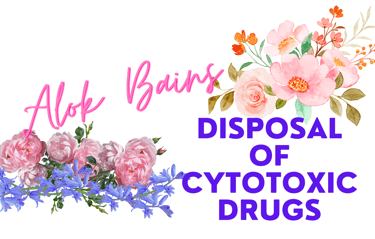Cytotoxic Drugs Disposal
Disposal of Cytotoxic Drugs
HOSPITAL PHARMACY
Alok Bains
4/27/20232 min read


Disposal of cytotoxic drugs
Compiled by: Alok Bains
Cytotoxic drugs are used in neoplastic conditions (cancer), organ transplantation, and collagen vascular disorders. They are used in oncology, radiotherapy, transplant and immunology unit. They are used inside hospital departments and also in clinics outside hospitals. Their uses are increasing due to an increase in carcinoma, transplants and immunological disorders. Cytotoxic drugs come under the genotoxic category. They are extremely hazardous due to their genotoxic nature. Genotoxics are toxic to deoxyribonucleic acid. Cytotoxic wastes have also genotoxic properties.
Sources:
Cytotoxic drugs and Cytotoxic waste. Unused (leftover) cytotoxic drugs, expired cytotoxic drugs, returned drugs,
Any materials that come in contact with cytotoxic drugs are “cytotoxic waste” such as packaging materials, syringes, needles, drugs bag, protective clothes, etc. Vomit, urine or faeces of patients consuming cytotoxic drugs have also cytotoxic waste.
Disposal
The cytotoxic committee decides the policy and procedures for disposal of the cytotoxic drugs and cytotoxic wastes. The followings are the summary of the disposal of cytotoxic drugs and cytotoxic waste.
Healthcare workers handling cytotoxic drugs and cytotoxic wastes shall wear Personal protective equipment (PPE) and will handle it with full caution. The following steps shall be followed:
Segregation: Cytotropic drugs and cytotoxic waste should not be mixed with other drugs or wastes. Place them separately in a closed, leak-proof nonchlorinated double plastic bag.
Transportation: Place these plastic bags in rigid, sealed, leak-proof and tear-resistant containers marked with the “Cytotoxic” hazard symbol. Hospital management may fix the colour of these containers.
Disposal techniques: Cytotoxic drugs and cytotoxic wastes should never be disposed of by landfill or by flushing in the sewerage. The following techniques are used for cytotoxic drugs and cytotoxic waste disposal.
Return to the supplier or take-back program for unused (leftover) or expired cytotoxic drugs.
High-Temperature Incineration: Complete destruction of cytotoxic drugs requires double chambered incinerator. Incineration at 1200 degrees C with sufficient residence time inside the second chamber with gas cleaning equipment. Incineration at a lower temperature is avoided because it releases hazardous cytotoxic vapour into the atmosphere. Incineration in a single-chamber incinerator or by open-air burning is also hazardous.
Autoclave, microwave and steam treatment minimize the hazards of cytotoxic drugs and cytotoxic waste. These are considered if incineration facilities are not available.
Chemical degradation: They can be disposed of by chemical decomposition as advised by the manufacturers of cytotoxic drugs. But it requires the services of experts to manage drug residues and contaminated urine, faeces, spillages, clothing etc. This technique is not suitable for contaminated body fluids.
Encapsulation,
Inertization
Alkaline hydrolysis.
These three technologies are used if high-temperature incineration or chemical decomposition is not suitable or feasible.
The novel techniques for their disposal include global environmental facility technology reactor, alkaline hydrolysis, and thermophilic anaerobic digestion. However, high-temperature incineration is the best technique to dispose of cytotoxic drugs and cytotoxic wastes.
Compile by: Alok Bains
